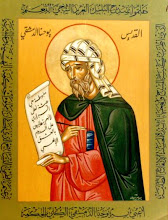After an imaginative interpretation of Rublev's Icon of the Holy Trinity (which view very traditional orthodox would sternly condemn), we come to this paragraph (emphasis added by your rambling host):
There is, indeed a "head" bishop, just as the father is the head of the Trinity. In the Church on Earth, in the first centuries, this head bishop was the Bishop of Rome, the most prominent See, and where saints Peter and Paul were martyred. In the year 451, at the fourth Ecumenical Council held in Chalcedon, this honor was accorded to the See of Constantinople, called "New Rome," as the center of the empire shifted. Since that time, the Patriarch of Constantinople has enjoyed the place of Primus — first hierarch.Now this interpretation of the twenty-eighth canon of the Council of Chalcedon as so stated is so egregiously wrong that I didn't know whether to reply with the facts or just shake my head at the silliness of it. Ultimately, I decided to ignore it.
However, over at Eirenikon a succinct retort to the typical Orthodox arguments related to the Council has found its way into blog-print. It comes from A. St. Leger Westall's The Fathers Gave Rome the Primacy from The Dublin Review in 1903. It is well worth reading.
Here is but a snippet:
The usual Anglican and Greek Orthodox interpretation of the canon is hat the Roman primacy was the gift either of the Nicene Fathers or the Fathers generally, and was a matter of mere ecclesiastical arrangement, and not, as Rome teaches, an inheritance from St. Peter. To this view there are four main objections, each one of which appears to be fatal, and in the cumulative force are so beyond all contradiction. First, the statement, thus interpreted is historically false. Secondly, it expressly contradicts the other explicit statements of the council, and renders its letter to Leo absolutely meaningless. Thirdly, the authors of the canon would have defeated their own purpose, for they would have knowingly and wilfully made it impossible for the Pope to ratify the canon, and their success depended, as they themselves assert, on gaining his assent. Fourthly, it makes the attitude of the Pope towards the canon inexplicable. Although one of the strongest champions of the Petrine claims of his see that history can produce, he betrays from the first to last no consciousness that this crucial statement affected, or was meant to affect, the privileges of his chair as the “Cathedra Petri.”Also of interest, one might profit by going here, here, and here.
Nowadays, Constantinople typically references canon 28 as justification for claiming all Orthodox Churches in diaspora (read: anywhere outside the traditional geographical limits of the Pentarchy) are under its jurisdiction. This claim, not surprisingly, is typically denied in strong terms by the Patriarchate of Moscow and most of those following the Slavic Tradition. Amongst Rome's original objections was that it placed Constantinople ahead of Alexandria and Antioch, both ancient Sees founded by St Peter. So be it.
Having said all this, I re-assert that it is my usual habit not to enter into polemical discussions with the Orthodox. But lest anyone be misled by the views put forth in the P&C article noted above, I felt compelled to address them at least this much.


3 comments:
Definitely listen to Metropolitan Philip. Quite good and deals with Canon 28 a lot:
http://byztex.blogspot.com/2008/06/st-vladimirs-seminary-lectures-rome.html
The angel to the left (as we view it) represents (not depicts) God the Father,
That's true. What's Your problem with that?
The Father, as the Head of the Godhead, is the one that originates the Son through birth and the Spirit through procession. That's why He's called Fount or Fountainhead. It's not just because He's the Head as in `being greater` (John 10:29).
So, does the Pope consacrate all of the Bishops everywhere? Did he historically do that? Did St. Peter, the Eldest and Chief among the Twelve, do that? Was it Peter who blowed the Holy Ghost upon the 120 men and said to them: "take ye the Holy Spirit"? Is it him whom he himself calls "the Bishop of souls" (1 Peter 2:25), or whom his friend Paul, the Chief among the Seventy, calls Great-Priest or Arch-Priest? Do You now finally understand? Can You see how things have changed from "a bishop is to be insatalled by two or three bishops" (ancient and apostolic canons) to what we have "today" in the Roman Catholic Church, when every single bishop is appointed by the Pope?
Is a deacon appointed by the laity? Is a Priest appointed by the Diaconate? Is a Bishop consacrated by his Presbyters? If "no", the how come that the Cardinals can appoint a Pope? No-one gives what he doesn't have.
Typologically, Deacons reflect the Levites, Presbyters the Priests, and the Bishop the Arch-Priest? Where does the "excluded fourth" (the Pope) fit into this picture? Does St. Dyonisius the Areopagite speak of a Tetrad, or of a Triad, when discussing Holy Orders, Angelic ranks, and so on?
Peter's name is tied to all the three capitals od the Ancient World: Antioch, where he stayed a lot, since they were Semites and he was an Apostle of/to the Circumcision (Galatians 2:7); in Alexandria, where he consacrated Mark the Evangelist as their Bishop; and in Rome where he received his glorious martyrdom. Which one is the See of Peter? (Did Peter write the Epistle to the Romans? Does he write his Epistle from Rome or Babylon, where both Scripture and tradition place him?).
Post a Comment